Business Performance Analysis: Strategies for Lidl's Improvement in UK
VerifiedAdded on 2020/02/03
|46
|8810
|108
Report
AI Summary
This report offers a comprehensive analysis of Lidl's business performance in the UK, focusing on key challenges and strategic recommendations. It begins with an executive summary outlining the need for businesses to identify and overcome issues to enhance performance and competitiveness. The report then delves into Lidl's mission statement, market position, and the competitive landscape, highlighting issues such as long queues, lack of online shopping, and absence of loyalty cards. The report assesses Lidl's performance using the Hayes & Wheelwright framework, placing it in the second stage, and proposes three key operational changes: self-checkouts, an online shopping store, and loyalty cards. Investment appraisal methods such as Payback Period, SAFE criteria, Net Present Value, and Performance Matrix are utilized to evaluate the proposed changes, concluding that introducing an online shopping portal is the most suitable option for Lidl to improve sales, profitability, and customer satisfaction. The report also includes illustrations and tables to support the analysis and concludes with a summary of findings and recommendations. The report is a valuable resource for understanding Lidl's business strategies and challenges.
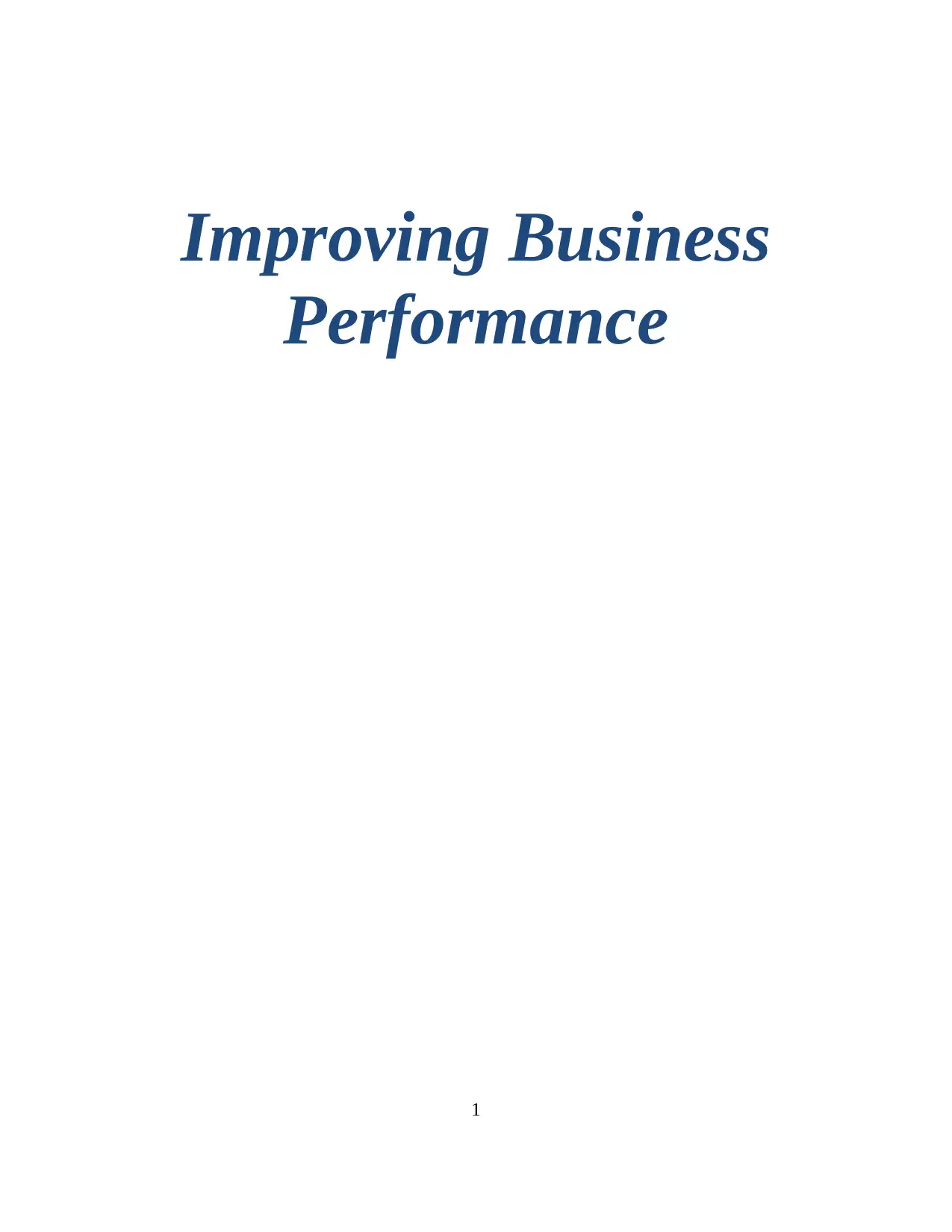
Improving Business
Performance
1
Performance
1
Paraphrase This Document
Need a fresh take? Get an instant paraphrase of this document with our AI Paraphraser

EXECUTIVE SUMMARY
In the current scenario, every business enterprise is required to identify major issues and
challenges which it is facing. Further, organizations are also required to seek for the ways
through they can overcome those issues and enhance its performance. It can be also stated that at
the time of operating in business environment, businesses needs to stay competitive in order to
achieve higher profits and sales. It is also required by organizations to make changes in their
process, product and services at regular intervals in order to attract customers. Lidl is one of the
most renowned chains of retail supermarkets in UK and at present it is facing different types of
issues. It can be also explained that introducing online shopping stores will help the brand to
overcome its issues and find better opportunities related to growth and development.
2
In the current scenario, every business enterprise is required to identify major issues and
challenges which it is facing. Further, organizations are also required to seek for the ways
through they can overcome those issues and enhance its performance. It can be also stated that at
the time of operating in business environment, businesses needs to stay competitive in order to
achieve higher profits and sales. It is also required by organizations to make changes in their
process, product and services at regular intervals in order to attract customers. Lidl is one of the
most renowned chains of retail supermarkets in UK and at present it is facing different types of
issues. It can be also explained that introducing online shopping stores will help the brand to
overcome its issues and find better opportunities related to growth and development.
2

TABLE OF CONTENTS
Introduction .....................................................................................................................................5
Task 1...............................................................................................................................................5
Task 2...............................................................................................................................................5
Task 3...............................................................................................................................................6
Task 4 ..............................................................................................................................................8
Task 5.............................................................................................................................................11
Task 6.............................................................................................................................................14
Task 7.............................................................................................................................................14
Task 8.............................................................................................................................................22
Conclusion ....................................................................................................................................24
References......................................................................................................................................25
Appendix........................................................................................................................................27
3
Introduction .....................................................................................................................................5
Task 1...............................................................................................................................................5
Task 2...............................................................................................................................................5
Task 3...............................................................................................................................................6
Task 4 ..............................................................................................................................................8
Task 5.............................................................................................................................................11
Task 6.............................................................................................................................................14
Task 7.............................................................................................................................................14
Task 8.............................................................................................................................................22
Conclusion ....................................................................................................................................24
References......................................................................................................................................25
Appendix........................................................................................................................................27
3
⊘ This is a preview!⊘
Do you want full access?
Subscribe today to unlock all pages.

Trusted by 1+ million students worldwide
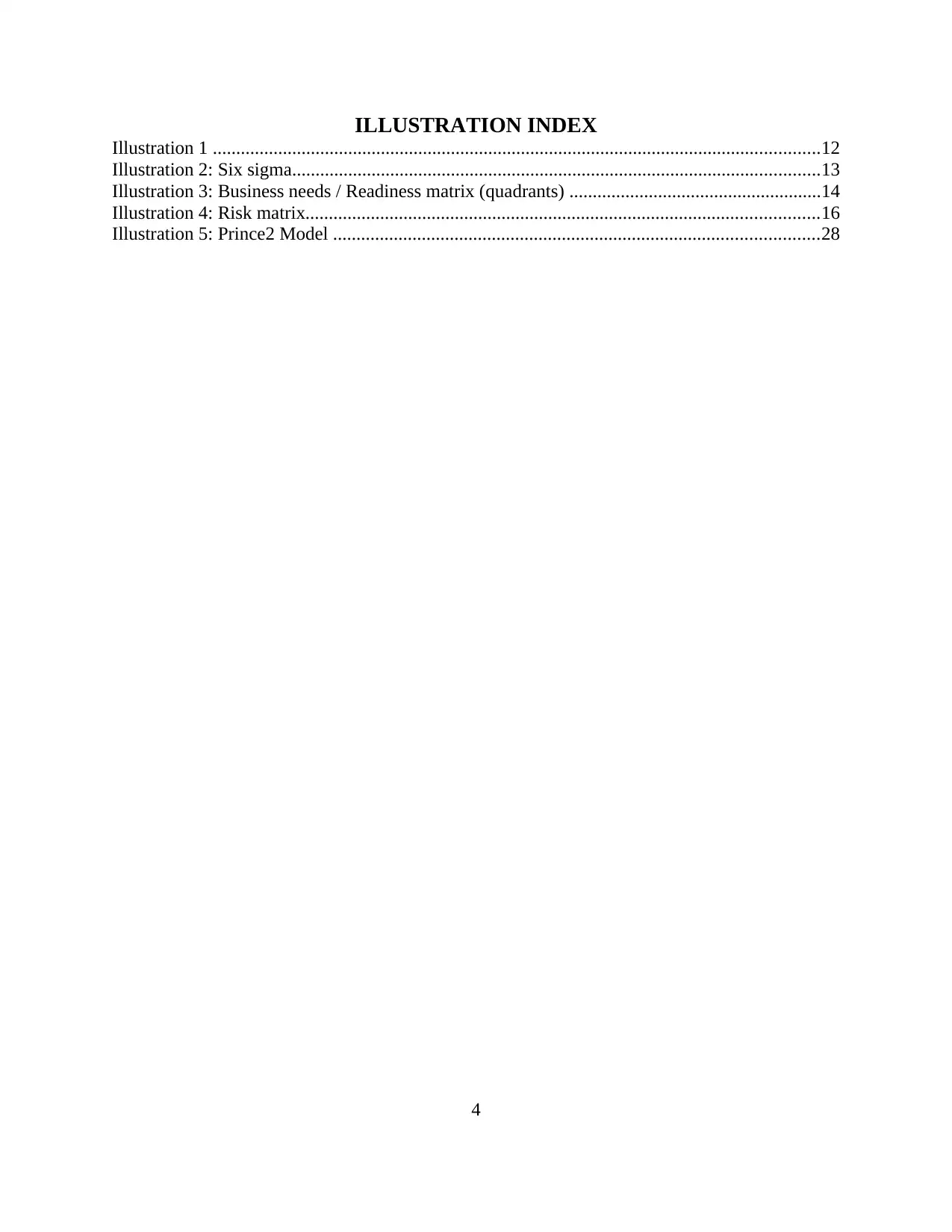
ILLUSTRATION INDEX
Illustration 1 ..................................................................................................................................12
Illustration 2: Six sigma.................................................................................................................13
Illustration 3: Business needs / Readiness matrix (quadrants) ......................................................14
Illustration 4: Risk matrix..............................................................................................................16
Illustration 5: Prince2 Model ........................................................................................................28
4
Illustration 1 ..................................................................................................................................12
Illustration 2: Six sigma.................................................................................................................13
Illustration 3: Business needs / Readiness matrix (quadrants) ......................................................14
Illustration 4: Risk matrix..............................................................................................................16
Illustration 5: Prince2 Model ........................................................................................................28
4
Paraphrase This Document
Need a fresh take? Get an instant paraphrase of this document with our AI Paraphraser

INTRODUCTION
In the present scenario, the competition among businesses in retail supermarkets of UK
has become very intense. In order to survive in market and earn higher profits, organizations are
required to improve their overall performance at regular intervals. This will support in enhancing
the overall competitiveness of businesses. Along with this, it also assists in attracting more and
more customers which results in increasing sales and profitability. The present report is based on
three issues which are faced by Lidl. Furthermore, it also highlights three major changes required
to enhance overall operational performance of the organization.
TASK 1
The mission statement of Lidl reflects that the retailer respects cultural variety and
differences which lies in tradition and value.
Lidl is Germany based grocery retailer which was started in the year 1930. The retailer is
carrying out its operations with the help of more than 10000 stores. Further, it offers different
range of products which includes organic products, eggs, sunflower oil etc. One of the most
important factors which have contributed in the success of retailer is that it has always kept
health and safety of customers as its primary concern (Bath, Button and Rayman, 2014). Lidl has
been always successful in offering the best quality of products and services to all its customers.
At the time of carrying out its operations in UK, Lidl faces very tough competition from market
players such as Aldi, Sainsbury and Morrison. The operations of Lidl can be termed as very
effective one as along with following all legal rules and regulations, the retailer is also taking
care of its corporate social responsibility in appropriate manner.
TASK 2
After carrying out evaluation of Lidl's performance, it can be stated that the sales and
profits of organization is increasing at a moderate rate. However, it can be argued that the brand
is facing issues related to its customers and website. People are no longer interested in waiting
for long queues and complaining regarding the same. Along with this, they are also asking Lidl
to bring its online shopping store in order to make the entire process of purchase more
convenient. In the year 2013, the brand generated €63,35 billion euro revenue and in the year it
5
In the present scenario, the competition among businesses in retail supermarkets of UK
has become very intense. In order to survive in market and earn higher profits, organizations are
required to improve their overall performance at regular intervals. This will support in enhancing
the overall competitiveness of businesses. Along with this, it also assists in attracting more and
more customers which results in increasing sales and profitability. The present report is based on
three issues which are faced by Lidl. Furthermore, it also highlights three major changes required
to enhance overall operational performance of the organization.
TASK 1
The mission statement of Lidl reflects that the retailer respects cultural variety and
differences which lies in tradition and value.
Lidl is Germany based grocery retailer which was started in the year 1930. The retailer is
carrying out its operations with the help of more than 10000 stores. Further, it offers different
range of products which includes organic products, eggs, sunflower oil etc. One of the most
important factors which have contributed in the success of retailer is that it has always kept
health and safety of customers as its primary concern (Bath, Button and Rayman, 2014). Lidl has
been always successful in offering the best quality of products and services to all its customers.
At the time of carrying out its operations in UK, Lidl faces very tough competition from market
players such as Aldi, Sainsbury and Morrison. The operations of Lidl can be termed as very
effective one as along with following all legal rules and regulations, the retailer is also taking
care of its corporate social responsibility in appropriate manner.
TASK 2
After carrying out evaluation of Lidl's performance, it can be stated that the sales and
profits of organization is increasing at a moderate rate. However, it can be argued that the brand
is facing issues related to its customers and website. People are no longer interested in waiting
for long queues and complaining regarding the same. Along with this, they are also asking Lidl
to bring its online shopping store in order to make the entire process of purchase more
convenient. In the year 2013, the brand generated €63,35 billion euro revenue and in the year it
5
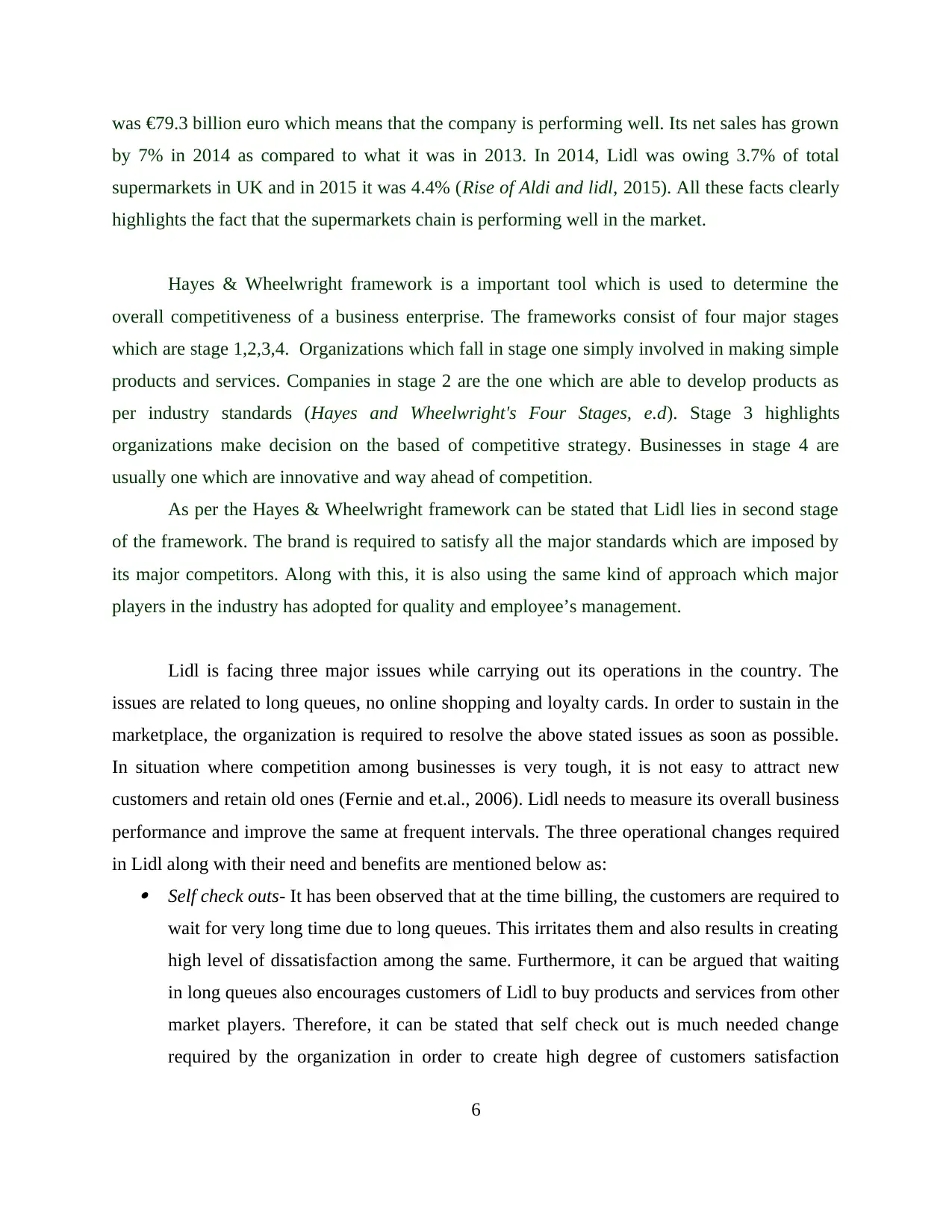
was €79.3 billion euro which means that the company is performing well. Its net sales has grown
by 7% in 2014 as compared to what it was in 2013. In 2014, Lidl was owing 3.7% of total
supermarkets in UK and in 2015 it was 4.4% (Rise of Aldi and lidl, 2015). All these facts clearly
highlights the fact that the supermarkets chain is performing well in the market.
Hayes & Wheelwright framework is a important tool which is used to determine the
overall competitiveness of a business enterprise. The frameworks consist of four major stages
which are stage 1,2,3,4. Organizations which fall in stage one simply involved in making simple
products and services. Companies in stage 2 are the one which are able to develop products as
per industry standards (Hayes and Wheelwright's Four Stages, e.d). Stage 3 highlights
organizations make decision on the based of competitive strategy. Businesses in stage 4 are
usually one which are innovative and way ahead of competition.
As per the Hayes & Wheelwright framework can be stated that Lidl lies in second stage
of the framework. The brand is required to satisfy all the major standards which are imposed by
its major competitors. Along with this, it is also using the same kind of approach which major
players in the industry has adopted for quality and employee’s management.
Lidl is facing three major issues while carrying out its operations in the country. The
issues are related to long queues, no online shopping and loyalty cards. In order to sustain in the
marketplace, the organization is required to resolve the above stated issues as soon as possible.
In situation where competition among businesses is very tough, it is not easy to attract new
customers and retain old ones (Fernie and et.al., 2006). Lidl needs to measure its overall business
performance and improve the same at frequent intervals. The three operational changes required
in Lidl along with their need and benefits are mentioned below as: Self check outs- It has been observed that at the time billing, the customers are required to
wait for very long time due to long queues. This irritates them and also results in creating
high level of dissatisfaction among the same. Furthermore, it can be argued that waiting
in long queues also encourages customers of Lidl to buy products and services from other
market players. Therefore, it can be stated that self check out is much needed change
required by the organization in order to create high degree of customers satisfaction
6
by 7% in 2014 as compared to what it was in 2013. In 2014, Lidl was owing 3.7% of total
supermarkets in UK and in 2015 it was 4.4% (Rise of Aldi and lidl, 2015). All these facts clearly
highlights the fact that the supermarkets chain is performing well in the market.
Hayes & Wheelwright framework is a important tool which is used to determine the
overall competitiveness of a business enterprise. The frameworks consist of four major stages
which are stage 1,2,3,4. Organizations which fall in stage one simply involved in making simple
products and services. Companies in stage 2 are the one which are able to develop products as
per industry standards (Hayes and Wheelwright's Four Stages, e.d). Stage 3 highlights
organizations make decision on the based of competitive strategy. Businesses in stage 4 are
usually one which are innovative and way ahead of competition.
As per the Hayes & Wheelwright framework can be stated that Lidl lies in second stage
of the framework. The brand is required to satisfy all the major standards which are imposed by
its major competitors. Along with this, it is also using the same kind of approach which major
players in the industry has adopted for quality and employee’s management.
Lidl is facing three major issues while carrying out its operations in the country. The
issues are related to long queues, no online shopping and loyalty cards. In order to sustain in the
marketplace, the organization is required to resolve the above stated issues as soon as possible.
In situation where competition among businesses is very tough, it is not easy to attract new
customers and retain old ones (Fernie and et.al., 2006). Lidl needs to measure its overall business
performance and improve the same at frequent intervals. The three operational changes required
in Lidl along with their need and benefits are mentioned below as: Self check outs- It has been observed that at the time billing, the customers are required to
wait for very long time due to long queues. This irritates them and also results in creating
high level of dissatisfaction among the same. Furthermore, it can be argued that waiting
in long queues also encourages customers of Lidl to buy products and services from other
market players. Therefore, it can be stated that self check out is much needed change
required by the organization in order to create high degree of customers satisfaction
6
⊘ This is a preview!⊘
Do you want full access?
Subscribe today to unlock all pages.

Trusted by 1+ million students worldwide
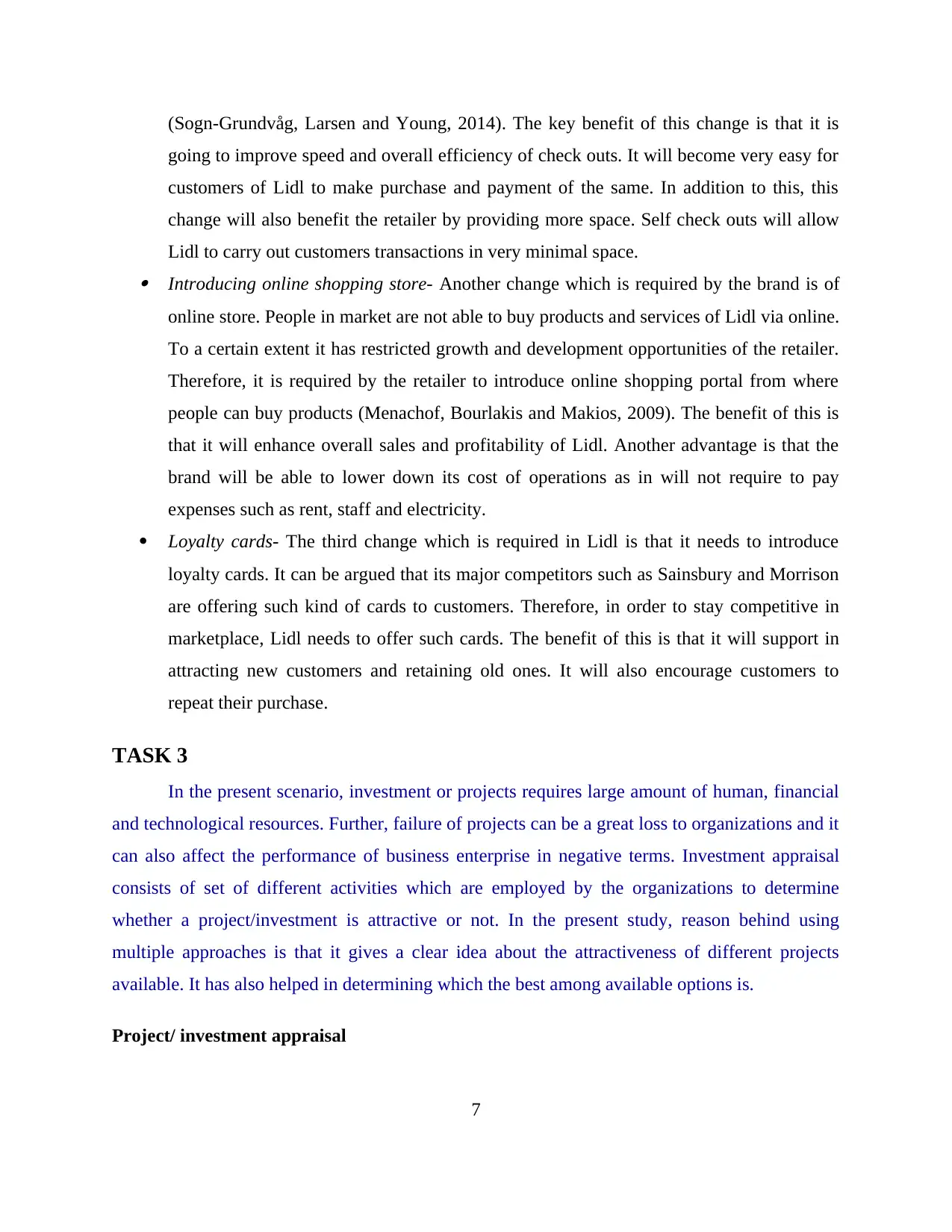
(Sogn‐Grundvåg, Larsen and Young, 2014). The key benefit of this change is that it is
going to improve speed and overall efficiency of check outs. It will become very easy for
customers of Lidl to make purchase and payment of the same. In addition to this, this
change will also benefit the retailer by providing more space. Self check outs will allow
Lidl to carry out customers transactions in very minimal space. Introducing online shopping store- Another change which is required by the brand is of
online store. People in market are not able to buy products and services of Lidl via online.
To a certain extent it has restricted growth and development opportunities of the retailer.
Therefore, it is required by the retailer to introduce online shopping portal from where
people can buy products (Menachof, Bourlakis and Makios, 2009). The benefit of this is
that it will enhance overall sales and profitability of Lidl. Another advantage is that the
brand will be able to lower down its cost of operations as in will not require to pay
expenses such as rent, staff and electricity.
Loyalty cards- The third change which is required in Lidl is that it needs to introduce
loyalty cards. It can be argued that its major competitors such as Sainsbury and Morrison
are offering such kind of cards to customers. Therefore, in order to stay competitive in
marketplace, Lidl needs to offer such cards. The benefit of this is that it will support in
attracting new customers and retaining old ones. It will also encourage customers to
repeat their purchase.
TASK 3
In the present scenario, investment or projects requires large amount of human, financial
and technological resources. Further, failure of projects can be a great loss to organizations and it
can also affect the performance of business enterprise in negative terms. Investment appraisal
consists of set of different activities which are employed by the organizations to determine
whether a project/investment is attractive or not. In the present study, reason behind using
multiple approaches is that it gives a clear idea about the attractiveness of different projects
available. It has also helped in determining which the best among available options is.
Project/ investment appraisal
7
going to improve speed and overall efficiency of check outs. It will become very easy for
customers of Lidl to make purchase and payment of the same. In addition to this, this
change will also benefit the retailer by providing more space. Self check outs will allow
Lidl to carry out customers transactions in very minimal space. Introducing online shopping store- Another change which is required by the brand is of
online store. People in market are not able to buy products and services of Lidl via online.
To a certain extent it has restricted growth and development opportunities of the retailer.
Therefore, it is required by the retailer to introduce online shopping portal from where
people can buy products (Menachof, Bourlakis and Makios, 2009). The benefit of this is
that it will enhance overall sales and profitability of Lidl. Another advantage is that the
brand will be able to lower down its cost of operations as in will not require to pay
expenses such as rent, staff and electricity.
Loyalty cards- The third change which is required in Lidl is that it needs to introduce
loyalty cards. It can be argued that its major competitors such as Sainsbury and Morrison
are offering such kind of cards to customers. Therefore, in order to stay competitive in
marketplace, Lidl needs to offer such cards. The benefit of this is that it will support in
attracting new customers and retaining old ones. It will also encourage customers to
repeat their purchase.
TASK 3
In the present scenario, investment or projects requires large amount of human, financial
and technological resources. Further, failure of projects can be a great loss to organizations and it
can also affect the performance of business enterprise in negative terms. Investment appraisal
consists of set of different activities which are employed by the organizations to determine
whether a project/investment is attractive or not. In the present study, reason behind using
multiple approaches is that it gives a clear idea about the attractiveness of different projects
available. It has also helped in determining which the best among available options is.
Project/ investment appraisal
7
Paraphrase This Document
Need a fresh take? Get an instant paraphrase of this document with our AI Paraphraser
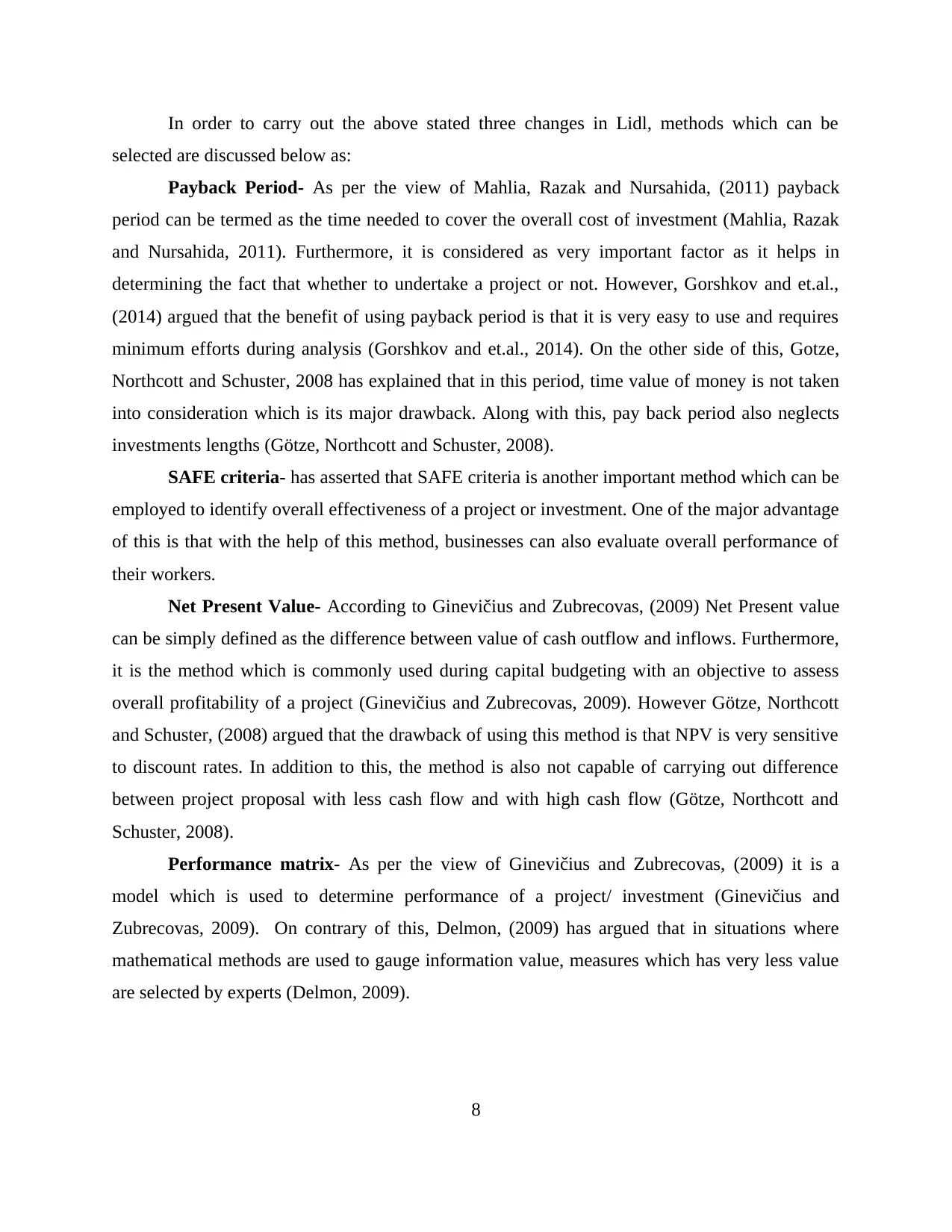
In order to carry out the above stated three changes in Lidl, methods which can be
selected are discussed below as:
Payback Period- As per the view of Mahlia, Razak and Nursahida, (2011) payback
period can be termed as the time needed to cover the overall cost of investment (Mahlia, Razak
and Nursahida, 2011). Furthermore, it is considered as very important factor as it helps in
determining the fact that whether to undertake a project or not. However, Gorshkov and et.al.,
(2014) argued that the benefit of using payback period is that it is very easy to use and requires
minimum efforts during analysis (Gorshkov and et.al., 2014). On the other side of this, Gotze,
Northcott and Schuster, 2008 has explained that in this period, time value of money is not taken
into consideration which is its major drawback. Along with this, pay back period also neglects
investments lengths (Götze, Northcott and Schuster, 2008).
SAFE criteria- has asserted that SAFE criteria is another important method which can be
employed to identify overall effectiveness of a project or investment. One of the major advantage
of this is that with the help of this method, businesses can also evaluate overall performance of
their workers.
Net Present Value- According to Ginevičius and Zubrecovas, (2009) Net Present value
can be simply defined as the difference between value of cash outflow and inflows. Furthermore,
it is the method which is commonly used during capital budgeting with an objective to assess
overall profitability of a project (Ginevičius and Zubrecovas, 2009). However Götze, Northcott
and Schuster, (2008) argued that the drawback of using this method is that NPV is very sensitive
to discount rates. In addition to this, the method is also not capable of carrying out difference
between project proposal with less cash flow and with high cash flow (Götze, Northcott and
Schuster, 2008).
Performance matrix- As per the view of Ginevičius and Zubrecovas, (2009) it is a
model which is used to determine performance of a project/ investment (Ginevičius and
Zubrecovas, 2009). On contrary of this, Delmon, (2009) has argued that in situations where
mathematical methods are used to gauge information value, measures which has very less value
are selected by experts (Delmon, 2009).
8
selected are discussed below as:
Payback Period- As per the view of Mahlia, Razak and Nursahida, (2011) payback
period can be termed as the time needed to cover the overall cost of investment (Mahlia, Razak
and Nursahida, 2011). Furthermore, it is considered as very important factor as it helps in
determining the fact that whether to undertake a project or not. However, Gorshkov and et.al.,
(2014) argued that the benefit of using payback period is that it is very easy to use and requires
minimum efforts during analysis (Gorshkov and et.al., 2014). On the other side of this, Gotze,
Northcott and Schuster, 2008 has explained that in this period, time value of money is not taken
into consideration which is its major drawback. Along with this, pay back period also neglects
investments lengths (Götze, Northcott and Schuster, 2008).
SAFE criteria- has asserted that SAFE criteria is another important method which can be
employed to identify overall effectiveness of a project or investment. One of the major advantage
of this is that with the help of this method, businesses can also evaluate overall performance of
their workers.
Net Present Value- According to Ginevičius and Zubrecovas, (2009) Net Present value
can be simply defined as the difference between value of cash outflow and inflows. Furthermore,
it is the method which is commonly used during capital budgeting with an objective to assess
overall profitability of a project (Ginevičius and Zubrecovas, 2009). However Götze, Northcott
and Schuster, (2008) argued that the drawback of using this method is that NPV is very sensitive
to discount rates. In addition to this, the method is also not capable of carrying out difference
between project proposal with less cash flow and with high cash flow (Götze, Northcott and
Schuster, 2008).
Performance matrix- As per the view of Ginevičius and Zubrecovas, (2009) it is a
model which is used to determine performance of a project/ investment (Ginevičius and
Zubrecovas, 2009). On contrary of this, Delmon, (2009) has argued that in situations where
mathematical methods are used to gauge information value, measures which has very less value
are selected by experts (Delmon, 2009).
8
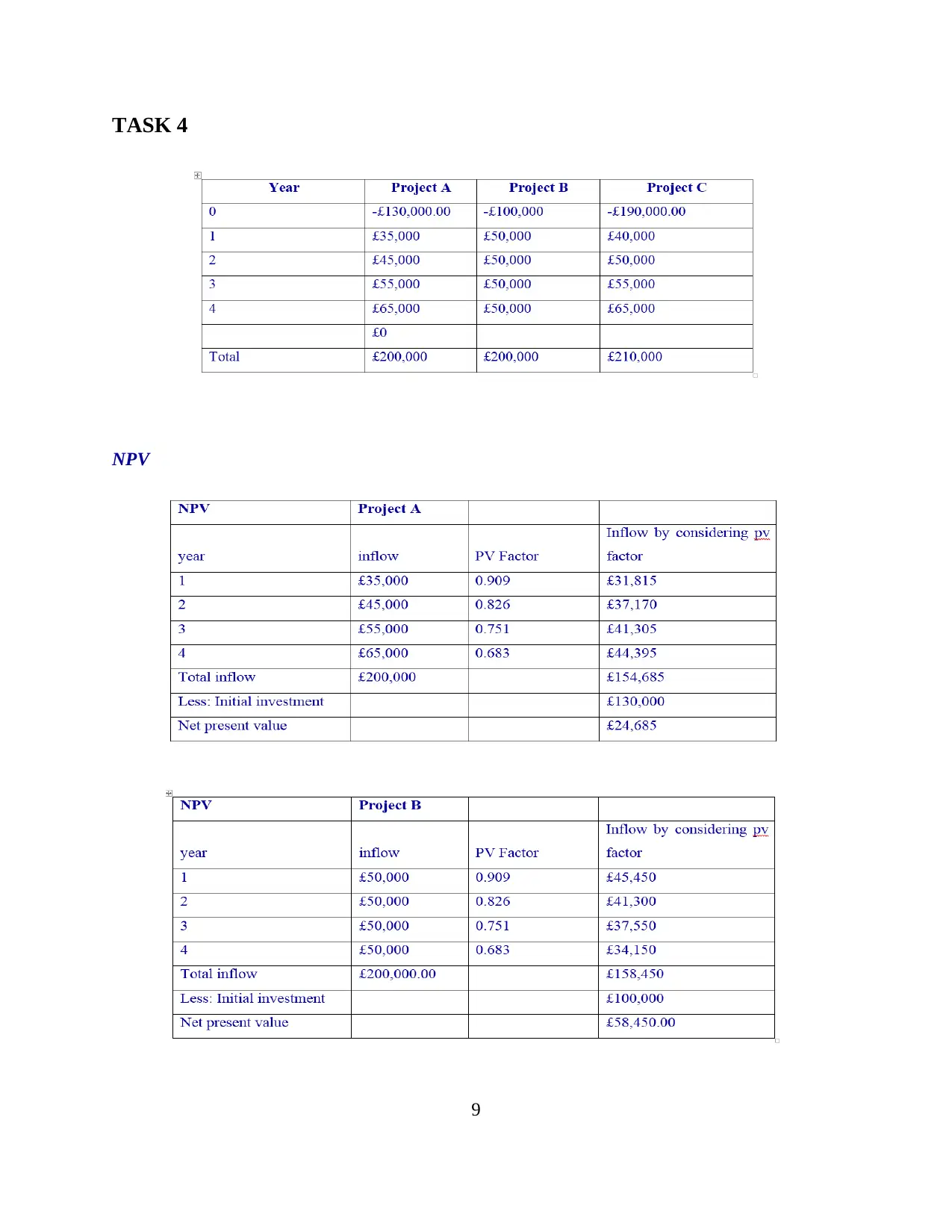
TASK 4
NPV
9
NPV
9
⊘ This is a preview!⊘
Do you want full access?
Subscribe today to unlock all pages.

Trusted by 1+ million students worldwide

Payback Period
10
10
Paraphrase This Document
Need a fresh take? Get an instant paraphrase of this document with our AI Paraphraser

Performance Matrix
Performance
parameter (Rating on
scale 1 to 10)
Project 1-
Establishing self
check outs
Project 2-
Introducing online
shopping portal
Project 3-
Introducing loyalty
cards
Safety 3 8 5
Time 4 7 6
Cost 6 4 6
Resources 5 9 8
Scope 5 9 7
Quality 7 8 8
Accuracy 6 7 9
Total 36 52 49
SAFE criteria
Project Suitability Acceptability feasibility
Project 1-
Establishing self
check outs
✓ _ ✓
Project 2-
Introducing online
✓ ✓ ✓
11
Performance
parameter (Rating on
scale 1 to 10)
Project 1-
Establishing self
check outs
Project 2-
Introducing online
shopping portal
Project 3-
Introducing loyalty
cards
Safety 3 8 5
Time 4 7 6
Cost 6 4 6
Resources 5 9 8
Scope 5 9 7
Quality 7 8 8
Accuracy 6 7 9
Total 36 52 49
SAFE criteria
Project Suitability Acceptability feasibility
Project 1-
Establishing self
check outs
✓ _ ✓
Project 2-
Introducing online
✓ ✓ ✓
11
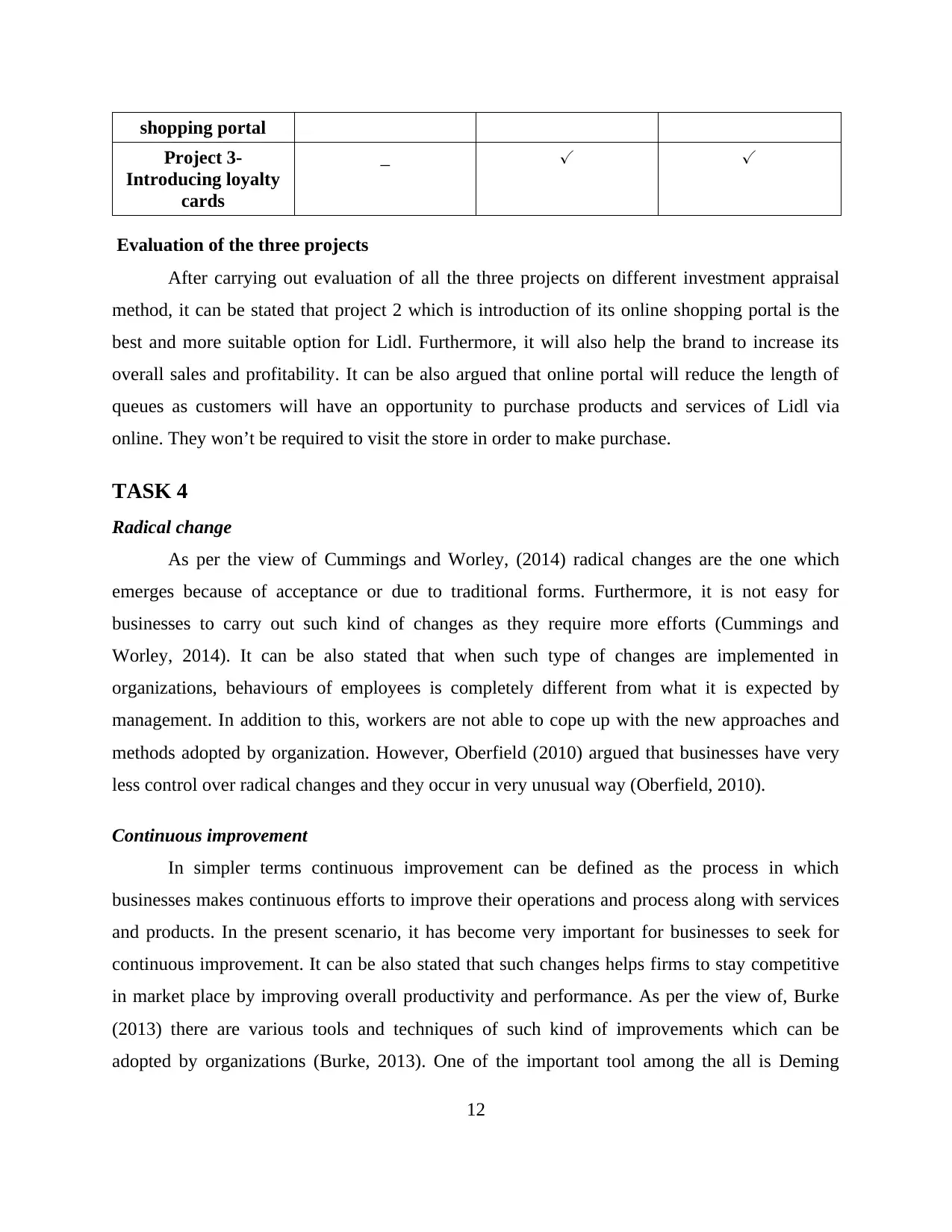
shopping portal
Project 3-
Introducing loyalty
cards
_ ✓ ✓
Evaluation of the three projects
After carrying out evaluation of all the three projects on different investment appraisal
method, it can be stated that project 2 which is introduction of its online shopping portal is the
best and more suitable option for Lidl. Furthermore, it will also help the brand to increase its
overall sales and profitability. It can be also argued that online portal will reduce the length of
queues as customers will have an opportunity to purchase products and services of Lidl via
online. They won’t be required to visit the store in order to make purchase.
TASK 4
Radical change
As per the view of Cummings and Worley, (2014) radical changes are the one which
emerges because of acceptance or due to traditional forms. Furthermore, it is not easy for
businesses to carry out such kind of changes as they require more efforts (Cummings and
Worley, 2014). It can be also stated that when such type of changes are implemented in
organizations, behaviours of employees is completely different from what it is expected by
management. In addition to this, workers are not able to cope up with the new approaches and
methods adopted by organization. However, Oberfield (2010) argued that businesses have very
less control over radical changes and they occur in very unusual way (Oberfield, 2010).
Continuous improvement
In simpler terms continuous improvement can be defined as the process in which
businesses makes continuous efforts to improve their operations and process along with services
and products. In the present scenario, it has become very important for businesses to seek for
continuous improvement. It can be also stated that such changes helps firms to stay competitive
in market place by improving overall productivity and performance. As per the view of, Burke
(2013) there are various tools and techniques of such kind of improvements which can be
adopted by organizations (Burke, 2013). One of the important tool among the all is Deming
12
Project 3-
Introducing loyalty
cards
_ ✓ ✓
Evaluation of the three projects
After carrying out evaluation of all the three projects on different investment appraisal
method, it can be stated that project 2 which is introduction of its online shopping portal is the
best and more suitable option for Lidl. Furthermore, it will also help the brand to increase its
overall sales and profitability. It can be also argued that online portal will reduce the length of
queues as customers will have an opportunity to purchase products and services of Lidl via
online. They won’t be required to visit the store in order to make purchase.
TASK 4
Radical change
As per the view of Cummings and Worley, (2014) radical changes are the one which
emerges because of acceptance or due to traditional forms. Furthermore, it is not easy for
businesses to carry out such kind of changes as they require more efforts (Cummings and
Worley, 2014). It can be also stated that when such type of changes are implemented in
organizations, behaviours of employees is completely different from what it is expected by
management. In addition to this, workers are not able to cope up with the new approaches and
methods adopted by organization. However, Oberfield (2010) argued that businesses have very
less control over radical changes and they occur in very unusual way (Oberfield, 2010).
Continuous improvement
In simpler terms continuous improvement can be defined as the process in which
businesses makes continuous efforts to improve their operations and process along with services
and products. In the present scenario, it has become very important for businesses to seek for
continuous improvement. It can be also stated that such changes helps firms to stay competitive
in market place by improving overall productivity and performance. As per the view of, Burke
(2013) there are various tools and techniques of such kind of improvements which can be
adopted by organizations (Burke, 2013). One of the important tool among the all is Deming
12
⊘ This is a preview!⊘
Do you want full access?
Subscribe today to unlock all pages.

Trusted by 1+ million students worldwide
1 out of 46
Related Documents
Your All-in-One AI-Powered Toolkit for Academic Success.
+13062052269
info@desklib.com
Available 24*7 on WhatsApp / Email
![[object Object]](/_next/static/media/star-bottom.7253800d.svg)
Unlock your academic potential
Copyright © 2020–2025 A2Z Services. All Rights Reserved. Developed and managed by ZUCOL.





